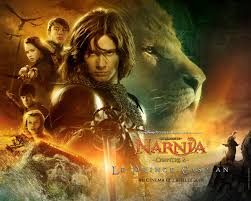 The Chronicles of Narnia is a series of seven fantasy novels for children written by C. S. Lewis. It is considered a classic of children's literature and is the author's best-known work, having sold over 120 million copies in 41 languages. Written by Lewis between 1949 and 1954 and illustrated by Pauline Baynes, The Chronicles of Narnia have been adapted several times, complete or in part, for radio, television, stage, and cinema. In addition to numerous traditional Christian themes, the series borrows characters and ideas from Greek and Roman mythology, as well as from traditional British and Irish fairy tales.
The Chronicles of Narnia is a series of seven fantasy novels for children written by C. S. Lewis. It is considered a classic of children's literature and is the author's best-known work, having sold over 120 million copies in 41 languages. Written by Lewis between 1949 and 1954 and illustrated by Pauline Baynes, The Chronicles of Narnia have been adapted several times, complete or in part, for radio, television, stage, and cinema. In addition to numerous traditional Christian themes, the series borrows characters and ideas from Greek and Roman mythology, as well as from traditional British and Irish fairy tales.The Lion, the Witch and the Wardrobe (1950)
The Lion, the Witch and the Wardrobe, completed in the winter of 1949 and published in 1950, tells the story of four ordinary children: Peter, Susan, Edmund, and Lucy Pevensie. They discover a wardrobe in Professor Digory Kirke's house that leads to the magical land of Narnia. The Pevensie children help Aslan save Narnia from the evil White Witch, who has reigned over the kingdom of Narnia for 100 years of perpetual winter.
Prince Caspian: The Return to Narnia (1951)
Completed in the autumn of 1949 and published in 1951, Prince Caspian: The Return to Narnia tells the story of the Pevensie children's second trip to Narnia. They are drawn back by the power of Susan's horn, blown by Prince Caspian to summon help in his hour of need. Caspian has fled into the woods to escape his uncle, Miraz, who had usurped the throne. The children set out once again to save Narnia; and aided by other Narnians, and ultimately by Aslan, they return the throne to Caspian, the rightful ruler.
The Voyage of the Dawn Treader (1952)
Completed in the winter of 1950 and published in 1952, The Voyage of the ‘Dawn Treader’ returns Edmund and Lucy Pevensie, along with their priggish cousin, Eustace Scrubb, to Narnia. Once there, they join Caspian's voyage to find the seven lords who were banished when Miraz took over the throne. This perilous journey brings them face to face with many wonders and dangers as they sail toward Aslan's country at the end of the world.
The Silver Chair (1953)
Completed in the spring of 1951 and published in 1953, The Silver Chair is the first Narnia book without the Pevensie children. Instead, Aslan calls Eustace back to Narnia together with his classmate Jill Pole. There they are given four signs to find Prince Rilian, Caspian's son, who had been kidnapped ten years earlier. Eustace and Jill, with the help of Puddleglum the Marsh-wiggle, face great danger before finding Rilian, held prisoner in an enchantment by a Green Witch.
The Horse and His Boy (1954)
Completed in the spring of 1950 and published in 1954, The Horse and His Boy takes place during the reign of the Pevensies in Narnia, an era which begins and ends in the last chapter of The Lion, the Witch and the Wardrobe. The story is about Bree, a talking horse, and a young boy named Shasta, both of whom have been held in bondage in Calormen. By chance, they meet each other and plan their return to Narnia and freedom. On their journey they discover that the Calormenes are about to invade Archenland, and they plan to arrive there first to alert the King.
The Magician's Nephew (1955)
Completed in the winter of 1954 and published in 1955, the prequel The Magician's Nephew brings the reader back to the very beginning of Narnia where we learn how Aslan created the world and how evil first entered it. Digory Kirke and his friend Polly Plummer stumble into different worlds by experimenting with magic rings made by Digory's uncle, encounter Jadis (The White Witch), and witness the creation of Narnia. Many long-standing questions about Narnia are answered in the adventure that follows.
The Last Battle (1956)
Completed in the spring of 1953 and published in 1956, The Last Battle chronicles the end of the world of Narnia. Jill and Eustace return to save Narnia from Shift, an ape, who tricks Puzzle, a donkey, into impersonating the lion Aslan, precipitating a showdown between the Calormenes and King Tirian.
To Download The Chronicles of Narnia, please click here (for US, Europe, Australia)
To Download The Chronicles of Narnia, please click here (for Asia, Indonesia)
No comments:
Post a Comment